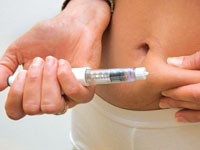Diabetes
Diabetes mellitus, or simply diabetes, is a group of metabolic diseases in which a person has high blood sugar, either because the pancreas does not produce enough insulin, or because cells do not respond to the insulin produced. High blood sugar produces the classical symptoms of polyuria (frequent urination), polydipsia (increased thirst), and polyphagia (increased hunger).

Insulin injection- insulin can be necessary for the management of diabetes
There are three main types of diabetes mellitus (DM).
- Type 1 DM results from the body’s failure to produce insulin, and currently requires the person to inject insulin or wear an insulin pump. This form was previously referred to as “insulin-dependent diabetes mellitus” (IDDM) or “juvenile diabetes”.
- Type 2 DM results from insulin resistance, a condition in which cells fail to use insulin properly, sometimes combined with an absolute insulin deficiency. This form was previously referred to as non insulin-dependent diabetes mellitus (NIDDM) or “adult-onset diabetes”.
- The third main form, gestational diabetes, occurs when pregnant women without a previous diagnosis of diabetes develop a high blood glucose level. It may precede development of type 2 DM.
Other forms of diabetes mellitus include congenital diabetes, which is due to genetic defects of insulin secretion, cystic fibrosis-related diabetes, steroid diabetes induced by high doses of glucocorticoids, and several forms of monogenic diabetes.
Untreated, diabetes can cause many complications. Acute complications include diabetic ketoacidosis and nonketotic hyperosmolar coma. Serious long-term complications include cardiovascular disease, chronic renal failure, and diabetic retinopathy (retinal damage). Adequate treatment of diabetes is thus important, as well as blood pressure control and lifestyle factors such as stopping smoking and maintaining a healthy body weight. Take a look at our diabetic foot care page
All forms of diabetes have been treatable since insulin became available in 1921, and type 2 diabetes may be controlled with medications. Insulin and some oral medications can cause hypoglycemia (low blood sugars), which can be dangerous if severe. Both types 1 and 2 are chronic conditions that cannot be cured.[3] Pancreas transplants have been tried with limited success in type 1 DM; gastric bypass surgery has been successful in many with morbid obesity and type 2 DM. Gestational diabetes usually resolves after delivery.
Insulin is the principal hormone that regulates uptake of glucose from the blood into most cells (primarily muscle and fat cells, but not central nervous system cells). Therefore, deficiency of insulin or the insensitivity of insulin receptors plays a central role in all forms of diabetes mellitus.
Humans are capable of digesting some carbohydrates, in particular those most common in food; starch, and some disaccharides such as sucrose, are converted within a few hours to simpler forms, most notably the monosaccharide glucose, the principal carbohydrate energy source used by the body. The rest are passed on for processing by gut flora largely in the colon. Insulin is released into the blood by beta cells (β-cells), found in the islets of Langerhans in the pancreas, in response to rising levels of blood glucose, typically after eating. Insulin is used by about two-thirds of the body’s cells to absorb glucose from the blood for use as fuel, for conversion to other needed molecules, or for storage.
Insulin is also the principle control signal for conversion of glucose to glycogen for internal storage in liver and muscle cells. Lowered glucose levels result both in the reduced release of insulin from the β-cells and in the reverse conversion of glycogen to glucose when glucose levels fall. This is mainly controlled by the hormone glucagon, which acts in the opposite manner to insulin. Glucose thus forcibly produced from internal liver cell stores (as glycogen) re-enters the bloodstream; muscle cells lack the necessary export mechanism. Normally, liver cells do this when the level of insulin is low (which normally correlates with low levels of blood glucose).
Higher insulin levels increase some anabolic (“building up”) processes, such as cell growth and duplication, protein synthesis, and fat storage. Insulin (or its lack) is the principle signal in converting many of the bidirectional processes of metabolism from a catabolic to an anabolic direction, and vice versa. In particular, a low insulin level is the trigger for entering or leaving ketosis (the fat-burning metabolic phase).
If the amount of insulin available is insufficient, if cells respond poorly to the effects of insulin (insulin resistance), or if the insulin itself is defective, then glucose will not have its usual effect, so glucose will not be absorbed properly by those body cells that require it, nor will it be stored appropriately in the liver and muscles. The net effect is persistent high levels of blood glucose, poor protein synthesis, and other metabolic derangements, such as acidosis.
When the glucose concentration in the blood is raised to about 9-10 mmol/L (except certain conditions, such as pregnancy), beyond its renal threshold(i.e. when glucose level surpasses the transport maximum of glucose reabsorption), reabsorption of glucose in the proximal renal tubuli is incomplete, and part of the glucose remains in the urine (glycosuria). This increases the osmotic pressure of the urine and inhibits reabsorption of water by the kidney, resulting in increased urine production (polyuria) and increased fluid loss. Lost blood volume will be replaced osmotically from water held in body cells and other body compartments, causing dehydration and increased thirst.
Diagnosis
| Condition | 2 hour glucose | Fasting glucose | HbA1c |
|---|---|---|---|
| mmol/l(mg/dl) | mmol/l(mg/dl) | % | |
| Normal | <7.8 (<140) | <6.1 (<110) | <6.0 |
| Impaired fasting glycaemia | <7.8 (<140) | ≥ 6.1(≥110) & <7.0(<126) | 6.0–6.4 |
| Impaired glucose tolerance | ≥7.8 (≥140) | <7.0 (<126) | 6.0–6.4 |
| Diabetes mellitus | ≥11.1 (≥200) | ≥7.0 (≥126) | ≥6.5 |
Diabetes mellitus is characterized by recurrent or persistent hyperglycemia, and is diagnosed by demonstrating any one of the following:[11]
- Fasting plasma glucose level ≥ 7.0 mmol/l (126 mg/dl)
- Plasma glucose ≥ 11.1 mmol/l (200 mg/dL) two hours after a 75 g oral glucose load as in a glucose tolerance test
- Symptoms of hyperglycemia and casual plasma glucose ≥ 11.1 mmol/l (200 mg/dl)
- Glycated hemoglobin (Hb A1C) ≥ 6.5%.[26]
A positive result, in the absence of unequivocal hyperglycemia, should be confirmed by a repeat of any of the above methods on a different day. It is preferable to measure a fasting glucose level because of the ease of measurement and the considerable time commitment of formal glucose tolerance testing, which takes two hours to complete and offers no prognostic advantage over the fasting test.[27] According to the current definition, two fasting glucose measurements above 126 mg/dl (7.0 mmol/l) is considered diagnostic for diabetes mellitus.
People with fasting glucose levels from 110 to 125 mg/dl (6.1 to 6.9 mmol/l) are considered to have impaired fasting glucose.[28] Patients with plasma glucose at or above 140 mg/dL (7.8 mmol/L), but not over 200 mg/dL (11.1 mmol/L), two hours after a 75 g oral glucose load are considered to have impaired glucose tolerance. Of these two prediabetic states, the latter in particular is a major risk factor for progression to full-blown diabetes mellitus, as well as cardiovascular disease.[29]
Glycated hemoglobin is better than fasting glucose for determining risks of cardiovascular disease and death from any cause.[30]
Managing diabetes
Diabetes mellitus is a chronic disease, for which there is no known cure except in very specific situations. Management concentrates on keeping blood sugar levels as close to normal (“euglycemia”) as possible, without causing hypoglycemia. This can usually be accomplished with diet, exercise, and use of appropriate medications (insulin in the case of type 1 diabetes; oral medications, as well as possibly insulin, in type 2 diabetes).
Patient education, understanding, and participation is vital, since the complications of diabetes are far less common and less severe in people who have well-managed blood sugar levels.[31][32]The goal of treatment is an HbA1C level of 6.5%, but should not be lower than that, and may be set higher.[33] Attention is also paid to other health problems that may accelerate the deleterious effects of diabetes. These include smoking, elevated cholesterol levels, obesity, high blood pressure, and lack of regular exercise.[33] Specialised footwear is widely used to reduce the risk of ulceration, or re-ulceration, in at-risk diabetic feet. Evidence for the efficacy of this remains equivocal, however.[34]
Lifestyle
There are roles for patient education, dietetic support, and sensible exercise, with the goal of keeping both short-term and long-term blood glucose levels within acceptable bounds. In addition, given the associated higher risks of cardiovascular disease, lifestyle modifications are recommended to control blood pressure.[35]
Medications
Metformin is generally recommended as a first line treatment for type 2 diabetes, as there is good evidence that it decreases mortality.[36] Routine use of aspirin, however, has not been found to improve outcomes in uncomplicated diabetes.[37]
Type 1 diabetes is typically treated with a combinations of regular and NPH insulin, or synthetic insulin analogs. When insulin is used in type 2 diabetes, a long-acting formulation is usually added initially, while continuing oral medications. Doses of insulin are then increased to effect.
Support
In countries using a general practitioner system, such as the United Kingdom, care may take place mainly outside hospitals, with hospital-based specialist care used only in case of complications, difficult blood sugar control, or research projects. In other circumstances, general practitioners and specialists share care of a patient in a team approach. Home telehealth support can be an effective management technique.[38]





